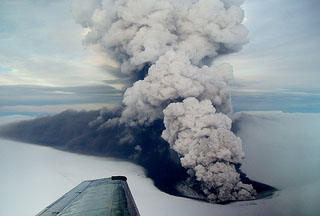Report on Grimsvotn (Iceland) — 10 January-16 January 2024
Smithsonian Institution / US Geological Survey
Weekly Volcanic Activity Report, 10 January-16 January 2024
Managing Editor: Sally Sennert.
Please cite this report as:
Global Volcanism Program, 2024. Report on Grimsvotn (Iceland) (Sennert, S, ed.). Weekly Volcanic Activity Report, 10 January-16 January 2024. Smithsonian Institution and US Geological Survey.
Grimsvotn
Iceland
64.416°N, 17.316°W; summit elev. 1719 m
All times are local (unless otherwise noted)
IMO reported that at 0653 on 11 January a M 4.3 earthquake occurred at Grímsvötn and was the largest earthquake recorded at the volcano since measurements started in 1991. A gradual increase in tremor was recorded at Mt. Grímsfjall, which rises about 300 m above the flat ice shelf over the subglacial lake, since 7 January and the water level in the Gígjukvísl River began to rise on 10 January. IMO noted that a jökulhlaup had likely begun and that the earthquake was in response to pressure release from the flood. The Aviation Color Code was raised to Yellow (the second level on a four-color scale) reflecting the slight increase in the likelihood of an eruption being triggered by the flood. IMO noted that the last eruption was in 2004; since then, 12 jökulhlaups had occurred with no eruptions.
Water levels in the Gígjukvísl River steadily and significantly increased during 11-12 January and the river widened; the river rose 70 cm based on data from a stream gauge at the bridge crossing Highway 1. The water level stabilized during 13-14 January, signifying that it had reached peak flow, and was then expected to subside. Around midnight on 15 January the seismometer at Grímsfjall began recording increased tremor, which was likely due to increased geothermal activity and is commonly observed at the end of a jökulhlaup.
Geological Summary. Grímsvötn, Iceland's most frequently active volcano in recent history, lies largely beneath the vast Vatnajökull icecap. The caldera lake is covered by a 200-m-thick ice shelf, and only the southern rim of the 6 x 8 km caldera is exposed. The geothermal area in the caldera causes frequent jökulhlaups (glacier outburst floods) when melting raises the water level high enough to lift its ice dam. Long NE-SW-trending fissure systems extend from the central volcano. The most prominent of these is the noted Laki (Skaftar) fissure, which extends to the SW and produced the world's largest known historical lava flow in 1783. The 15 km3 basaltic Laki lavas were erupted over 7 months from a 27-km-long fissure system. Extensive crop damage and livestock losses caused a severe famine that resulted in the loss of one-fifth of the population of Iceland.

